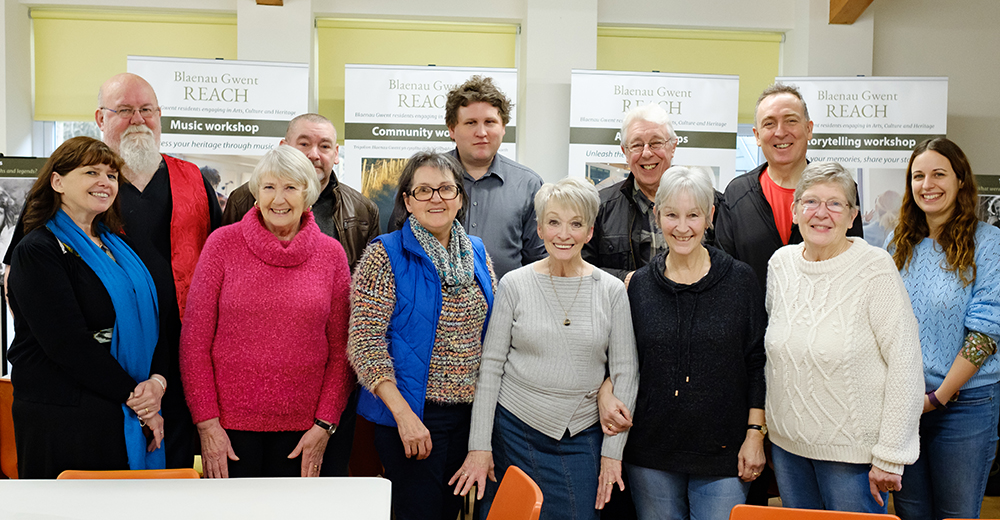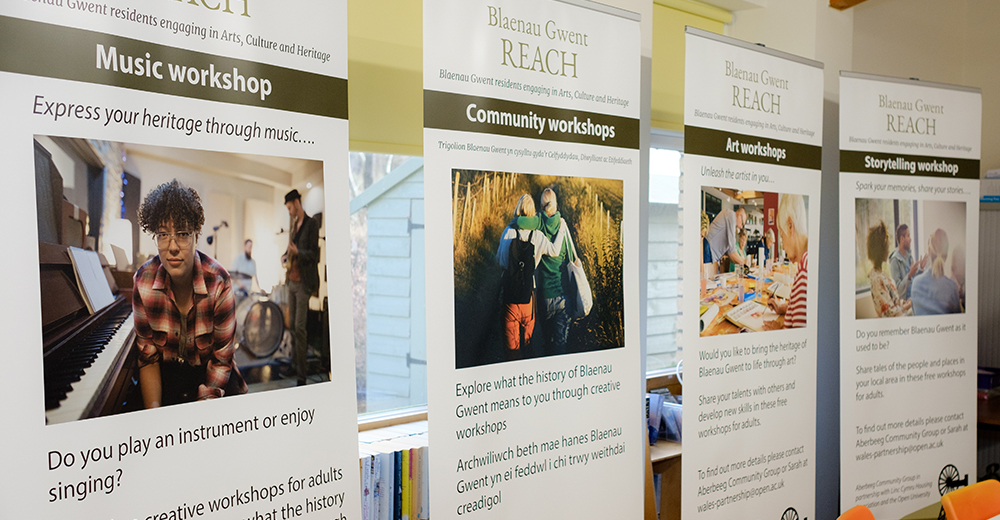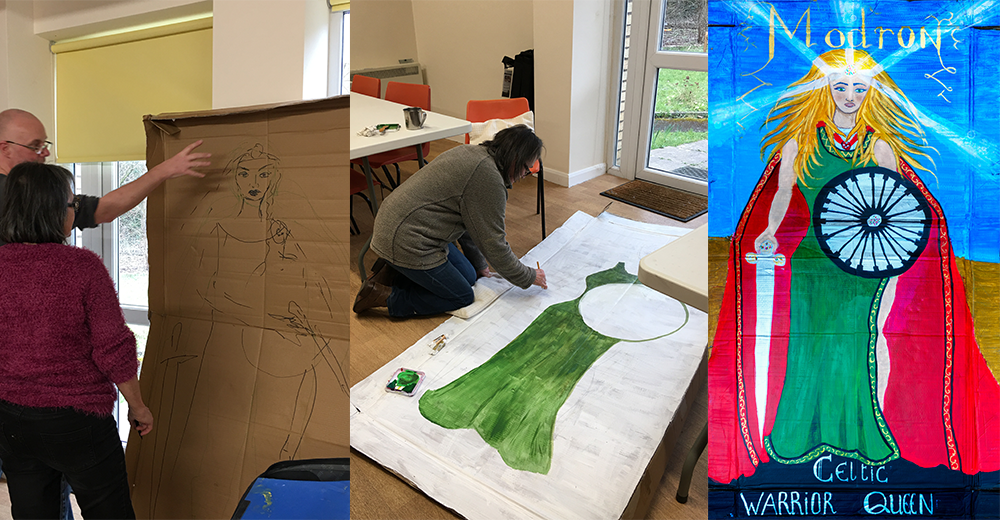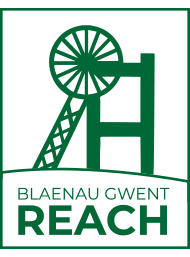
More than just a series of creative arts workshops
1 March 2020
By Richard Marsden, Director of Teaching for the School of Arts and Humanities at The Open University. He was the Academic Lead on BG REACH.
BG REACH was conceived in uncertainty and born in haste. At the time of writing it is also, thanks to Coronavirus, suffering an undignified and indefinite hiatus on its journey towards adolescence. Yet it has also flowered into something rather wonderful; far beyond my original hazy and half-baked idea.
On 5 September 2019 UK Research and Innovation announced a pot of money to support ‘place-based’ research projects working in partnership with local communities. The deadline for applications was 21 October 2019. That gave us just six weeks to develop a partnership between the Open University, Linc Cymru and Aberbeeg Community group, to work out a plan that everyone was happy with, and to make a convincing case for the money. In all honesty it was a mad scramble. We heard that we’d been successful on 27 November 2019, but the c.£37,500 we had won came with a requirement that the project kick off on 2 December 2019 – just five days later! All hands were summoned to get things moving; hindered rather than helped by the Open University’s frustratingly bureaucratic processes around research funding and partnerships.
But get things moving we did, thanks in large part to the hard work and enthusiasm of our partners in the Aberbeeg Community Group and Llys Glyncoed Care Home. They were the ones who drummed up interest in the project, working tirelessly to distribute flyers, run launch events, promote it on social media, and generally talk it up at every opportunity. Thanks to them, we have so far had over 100 attendees at BG REACH events since the start of February 2020.

What’s more, BG REACH has become far more than just a series of creative arts workshops building towards a project exhibition. Those session remain its core but, based on suggestions from our participants, a whole lot more has been added. For example, we are working with a local primary school choir on a song about local history to be performed at the launch of the project exhibition. The reminiscences of residents at Llys Glyncoed are now being recorded and made into digital stories by pupils from a local secondary school. The poems and short stories written by participants at the creative writing workshops are being recorded by a professional actor. And the pieces produced by community members involved in the visual art strand are being worked together into a single grand wall-hanging. None of this was in my original conception of the project. Nor was any of it in the bid that we submitted to get the funding. It has all come about on the hoof, as it were, thanks to the ideas of our fantastic participants.
The jargon of research refers to this kind of thing as ‘co-design’, ‘co-production; and ‘co-creation’. Really though it is just about working with people as partners in research rather than subjects. It’s not always easy to do; universities, funding bodies and even housing associations are often rife with inflexible processes and bureaucratic entanglements. But this project has already shown that it is absolutely worth the effort. I can’t wait to get cracking again! Rise, BG REACH, rise…!
Art / art history workshops
15 March 2020
By Dr Veronica Davies who teaches Art History for The Open University. She ran the visual art workshops on BG REACH.
Launching the art workshops
It took a while to find Aberbeeg community centre, the venue for our series of workshops, for the Saturday morning launch event, but when we did I was so impressed by what a good space it offered for the kind of thing we had in mind – a blend of a bit of art history and hands-on art-making. The banners advertising the workshops were eye-catching, and there was even a good blank wall on which to project slides! The other really encouraging aspect of the morning was to meet some of the people who had already been involved in getting this project off the ground, and some of the potential participants in the sessions, who had lots of questions about what we had planned, and whose enthusiasm to get started was palpable. They also told me a lot about Aberbeeg and the surrounding area, which suggested plenty of possibilities for visual exploration of local heritage in addition to those I had already researched.
First week – Wednesday morning
It was good to meet artist Andy O’Rourke beforehand, having already been in touch to discuss this first workshop. The fact that this was half term meant we had a broad age range in attendance. Once the necessary paperwork was out of the way, we started with a slide presentation based on the ‘Pitmen Painters’, a group of miner artists in north-east England in the 1930s and 40s. I chose this as an interesting story in itself, which could connect with Aberbeeg’s local mining heritage, and also because there seemed to be connections between what the ‘Pitmen Painters’ did, and what we hoped to achieve in our workshops. Andy then took over, and we set to work on making ‘metallic’ plaques based on local imagery and the area’s industrial heritage, and incorporating the letters of Aberbeeg, with a view to starting to build up a collection of work that can be exhibited. This was a really good starter activity introducing a technique that was new to participants, but one that everyone could join in to produce a piece of work they could be pleased with during the time available for the workshop.
Second week
Despite persistent flooding that closed one of the roads locally, and threats of snow, we all got there, and welcomed Andy’s colleague Kate who came with the materials for participants to try a printing technique. With than in mind, my art history talk was about artists’ printmaking, and including a print of the Chartists in Newport which got people talking. We had a slightly different group this time, but equally involved and enthusiastic. The prints the group made were a mix of local images, like the Guardian figure in Six Bells, and more general ones, such as flowers. Again we had some impressive results which would be good to include in the exhibition. There was also time to discuss with a couple of the group, with the help of a few slides on the laptop and a large painting/collage work that Kate had done with a different group, thoughts about how some aspect of needlework or textiles more generally could be incorporated into the workshops, bearing in mind time constraints.
Third week – Friday afternoon
While the floods are abating, we get rumours of coming pestilence. There were fewer participants this time, maybe because of this, or maybe it’s not such a convenient day/time. In terms of art history, we looked at the genre of scenes of everyday life historically – there was definite interest in works that can be seen locally, e.g. in National Museum Wales, and in possibilities for a group visit. Lowry’s painting of Six Bells in particular got a lot of discussion going. We also looked at Andy’s mock-up for how the work we’re making could be displayed for exhibition, and that received positive support. Some participants have decided on longer projects with the help of our collaborating artists, e.g. Barbara’s life-size painting of a Celtic warrior princess. Others took the opportunity to do some smaller paintings of local scenes with Andy’s support and advice. It was interesting, from an art historian’s point of view, to see the resonances of the Lowry we’d looked at in these. We were delighted to have the chance to see some superb needlework done some time ago by one of the group, Hilary: a panel depicting Aberbeeg incorporated in a large cape.

Fourth week
We welcomed Kate back for her second session as our collaborating artist. The outbreak of coronavirus is clearly starting to affect attendance, as some participants are temporarily withdrawing from public life. Knowing who would be likely to attend, I revisited the early list of suggested themes, with slides on ‘Art, activism and protest’, connecting with Celts, Chartists, poster art, mining union banners, and the ‘save the canyon’ project, as two participants, Hazel and Emily, were returning to work on a collage and landscape painting based on this. As we had anticipated before the workshops started, at this point pretty much everyone was getting on with their own or joint projects they had already started. I do so hope the impetus will remain to pick these up, and hopefully bring back a few other participants, once we’re in a position to resume the workshops.
The beauty and talent of Blaenau Gwent
12 February 2021
By Suzanne Bowers, Linc Cymru Community Engagement Officer
What do you get when you take the people of Blaenau Gwent, The Open University and Linc-Cymru Housing Association? A brilliant project full of talent, enthusiasm and fun!
BG REACH was first conceived in 2019. The project's aim was to invite the people of Blaenau Gwent to explore their rich heritage through history, art, creative writing and music. Aberbeeg Community Group were absolutely immovable on one point – they told us “Every time we hear about Blaenau Gwent on the telly or in the newspapers, it’s always so negative, we don’t want that for this project. We want to show people the talent and beauty of the area”.
When the three partners – Aberbeeg Community Group, The Open University and Linc-Cymru Housing Association – started to talk about the creation of BG REACH, there was so much excitement, but also trepidation. Members of the community group were unsure of how the project would work. Would it be like school? The Open University lecturers using language that was inaccessible to all? Judging people for their ability? A lot of people were very concerned that having had a bad experience at school many years ago it could come back to haunt them. We needed to make sure that attitudes were changed.
Members of the community group were unsure of how the project would work. Would it be like school?
We approached the Ebbw Fawr Learning College to see if some of its pupils would like to get involved, the response was swift, they were delighted to join in. We explained that we would like the pupils to meet with Breaking Barriers, a community arts social enterprise. They would be taught how to interview and how to record audio and shoot video and finally how to edit them. Once they’d mastered the techniques, the pupils were invited to visit Llys Glyncoed an Extra care scheme in Ebbw Vale and record tenants’ stories.
We decided that it would be lovely if the first meeting between generations could be done in a relaxed informal way, so we put on a 'Vintage Day', items from decades ago that sparked memories were placed around Llys Glyncoed that allowed pupils and tenants to chat away. Singers were dressed in vintage costumes and sang songs, the pupils joined in by dancing and singing along. One tenant said, “I didn’t think they’d be interested in what we had to say, but they all sat and listened and asked questions, I really enjoyed it”.
Over the next few weeks, the pupils visited the tenants and captured some wonderful memories. Two pupils have since volunteered at Llys Glyncoed.
Art
The project kicked off with an art session, this was very well attended. People really enjoyed listening to Veronica who had come to talk about art history, she explained about a group of miners from Yorkshire who in the 1930’s had invited an artist to their institute to show them how to paint, some of the miners became so embroiled in art that they too become artists, people immediately found a connection with these men. Despite hearing lots of “I’m not very artistic” comments bouncing through the room Andy and Kate from Malaky Arts bought their wonderful skills and supported people to create the first pieces of work for the project.
Word got around very quickly that far from being a school environment, the first workshop had been great fun and people were so friendly and the tutors just got stuck in with everyone else. History was up next, Robert, the tutor started by going far back into the history of Blaenau Gwent to the Silures Tribe and explained how parts of that time were still visible on the top of the TWMBARLA. One participant said, “It has given us a thirst for learning, and we wanted to know more”. Over the next few weeks, the history group grew and grew.
After listening to the history session about the Surlies Tribe, Babs said she was so moved by what she had heard that she created a beautiful painting of Modron, a mythical Celtic Queen, in this painting she wanted to express the strength and determination of women, who have for centuries fought side by side with the men, weather that was in tribes or during the miner strike, their strength was there for everyone to see.
 The Modron painting in progress
The Modron painting in progress
Music
Music with Liz proved a joy, and many of the participants were able to show their wonderful talents by playing a wide variety of instruments. Around the table lyrics flowed and musical notes slotted together to create a unique piece of music that summed up the heritage of Blaenau Gwent. The local primary school Six Bells, heard about this and they wanted to get involved, they told us they had a choir and would like to work with Liz to write a song, that they would perform during the physical exhibition, we were delighted to welcome them into the project.
Creative writing
The other Liz took people through the joys of creative writing. Some people said they felt it helped them with their wellbeing by writing their thoughts down. Some had enjoyed writing many years ago but through lack of time hadn’t written for ages, after they had attended the sessions their passion for writing had returned once more. We were told that writing about something you know is often easier and so memories started to flooding back and long forgotten stories were once again brought back into the fold by beautiful descriptive writing. There are so many pieces of writing that have been produced, all of them so different, all of them so beautifully written you feel you are immerse in those memories.
As a result of this newfound joy for learning the Aberbeeg Community group have organised an internet connection for the centre so that they can encourage and continue learning, what a wonderful legacy.
Only two months into the project and the dreaded COVID hit! The project had been building nicely with new friendships being formed and people coming in from out of the area to join in the workshops. Undeterred, tutors and participants were determined to keep the project going and so music and creative writing sessions went online, and art packs were put together and delivered around Blaenau Gwent, the finished pieces of art took our breath away.
The outcomes of this project have been unimaginable. The spark has been well and truly lit in Blaenau Gwent, people have found learning to be fun , interesting and exciting. They’ve been able to spread their wings and discover their talents. I think most people have been shocked by their ability and have discovered the joy of learning and have embraced it. As a result of this newfound joy for learning the Aberbeeg Community group have organised an internet connection for the centre so that they can encourage and continue learning, what a wonderful legacy.
I would like to thank all who participated in this brilliant project, the tutors from the Open University for supporting people to feel relaxed and uncover the joy of learning, I would like to thank all participants for taking part, we value all the beautiful work that has been produced during this project, and are looking forward to showing it to the wider community during the online exhibition later this year and at The National Museum of Wales St Fagans in spring 2022.
What makes BG REACH different
18 March 2021
By Richard Marsden, Director of Teaching for the School of Arts and Humanities at The Open University. He was the Academic Lead on BG REACH.
A lot of our thinking about BG REACH has, quite rightly, focused on its social benefits. It is about enabling people to acquire new skills and have new experiences, to express themselves in new ways and, through the project exhibition, to combat the stigma often associated with post-industrial areas like Blaenau Gwent. It’s also a chance to work out how stuffy and hidebound universities can best collaborate with local communities and third sector organisations like housing associations.
But BG REACH is also a piece of research into how its participants think and feel about the history of their local area.
The premise here is that the ways in which people feel about the past play a big role in shaping how they think about the present. In other words, there is an important connection between history and identity. Historians tend to explore that by looking at what people leave behind; from news reports and official records to diaries and letters. That works well for fifty, a hundred, even a thousand years ago. But it’s not so good if you want to learn more about that relationship today.
Poems or drawings, stories or songs, developed and honed by their creators over many weeks or months; these are far fuller and more textured sources of information than answers to a questionnaire or a set of visitor statistics.
Sociologists are more likely to approach the subject with questionnaires and focus groups, asking people what they think. But the drawback there is that it puts people on the spot, making it harder to drill down into how they really feel about their own pasts and the history of the area they live in. Heritage experts, meanwhile, will look at the attractions that people visit; the country houses, the archaeological sites, the museums, and try to work out from that what they think about the past. But those places are usually run by professionals rather than community members, and are also often more about elites than ordinary people.
That’s not to say that the research that historians, sociologists and heritage professionals carry out is invalid. Far from it. My point is simply that there is room to try something different. And that is what BG REACH is doing. The idea is to support people from Blaenau Gwent to express their memories, their personal histories, and their sense of local heritage through the creative arts.
That might mean turning reminiscences into stories, using local myth as inspiration for poems or micro fiction, writing songs about the history of the area, or creating art that reflects the rich cultural and natural heritage of the county. These pieces will then be analysed for what they reveal about connections between past and present for the people who made them. Poems or drawings, stories or songs, developed and honed by their creators over many weeks or months; these are far fuller and more textured sources of information than answers to a questionnaire or a set of visitor statistics. It is this creative richness that the research element of BG REACH aims to tap into.
The results of this work would be fascinating for any part of Wales. But they are particularly important for places like Blaenau Gwent; eclipsed on the one hand by the metropolitan glamour of the M4 corridor and on the other by the romantic cachet of Welsh language culture in the North and West. The Gwent Valleys are part of Wales’s forgotten heritage, associated in the public eye with industrial fervour followed by economic collapse. Hopefully BG REACH will show that, for the people who live in them, there is rather more to it than that.
Warm Welsh Welcome at Aberbeeg
26 May 2021
 The Guardian statue overlooking Parc Arael Griffin, photo taken on a visit in early 2020
The Guardian statue overlooking Parc Arael Griffin, photo taken on a visit in early 2020
By Sarah Roberts, Partnerships Coordinator for The Open University in Wales and coordinator of the BG REACH project.
Every time me and Suzy went to Aberbeeg the sun was shining.
Our BG REACH road trips were less frequent than planned with the global pandemic throwing us and the world an epic curveball, but each one full of enthusiasm, plans and possibilities and always some emergency twirls supplied by Suzy for a much needed pick-me-up after hours of collaborative chatter.
Greeted by the wonderful warrior women of Aberbeeg Community Centre; Pat, Babs, Jacqui and Hilary, always with a smile and a cup of tea. Conversations with these community role models are uplifting even at the hardest times, and you can’t help but be inspired by their ideas, energy and ambition for their community, not only through the BG REACH project but through a whole host of opportunities they’re exploring to benefit the people around them.
As Cardiff dwellers, on each visit we tried to make time for a mini exploration of the area. BG REACH is after all about celebrating the beauty of Blaenau Gwent; the place, it’s people, it’s heritage, and Suzy with her passion for history was always more than willing to make a diversion so we could match the captivating stories from our partners at Aberbeeg with our stunning surroundings.
The peaceful beauty of the deep rolling valleys dotted with landmarks and striking historical buildings played a visual reminder of why it was important to tell others of this version of Blaenau Gwent through the BG REACH project.
Getting creative in Aberbeeg
11 June 2021
By Liz Ford, Staff Tutor in English at The Open University.
My visits to Aberbeeg to run a series of workshops in Creative Writing always brought new things – people, friends and experiences I will never forget.
I always received a warm welcome at the community centre, with tea, coffee, and even biscuits to dunk!
At every session, someone new would arrive with wonderful experiences to talk and write about in the group. We covered local histories with some fascinating accounts of growing up in the community and stories and memories about family members and friends, some now lost, but many still part of this vibrant and warm community of people who love the land so deeply.
I was constantly delighted by the willingness of the group members to share their ideas with others. Everyone had something to say, at times too much to say, and one or two had to be reined in and encouraged to write down what they were saying before it was forgotten in the midst of the chat! The lunching ladies writing group were a particularly welcome addition, particularly after, I suspect, a liquid lunch on their way!
When the pandemic struck, we moved online as we had no choice and the sessions continued. Again, I was delighted by the willingness to participate and one evening we even had students from the Lebanon join!
I look forward to this project continuing in other parts of Wales and I really hope we can keep our connections with the Aberbeeg community. I feel as though I have made many new friends.

This page is part of the Blaenau Gwent REACH online exhibition.
Film and audio | Creative writing | Visual art
Digital stories | The history of Blaenau Gwent | About this project
Rate and Review
Rate this article
Review this article
Log into OpenLearn to leave reviews and join in the conversation.
Article reviews